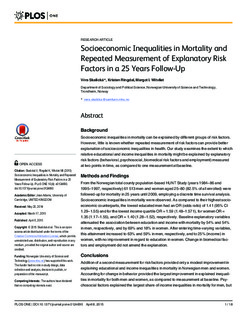| dc.description.abstract | Background
Socioeconomic inequalities in mortality can be explained by different groups of risk factors. However, little is known whether repeated measurement of risk factors can provide better explanation of socioeconomic inequalities in health. Our study examines the extent to which relative educational and income inequalities in mortality might be explained by explanatory risk factors (behavioral, psychosocial, biomedical risk factors and employment) measured at two points in time, as compared to one measurement at baseline.
Methods and Findings
From the Norwegian total county population-based HUNT Study (years 1984–86 and 1995–1997, respectively) 61 513 men and women aged 25–80 (82.5% of all enrolled) were followed-up for mortality in 25 years until 2009, employing a discrete time survival analysis. Socioeconomic inequalities in mortality were observed. As compared to their highest socioeconomic counterparts, the lowest educated men had an OR (odds ratio) of 1.41 (95% CI 1.29–1.55) and for the lowest income quartile OR = 1.59 (1.48–1.571), for women OR = 1.35 (1.17–1.55), and OR = 1.40 (1.28–1.52), respectively. Baseline explanatory variables attenuated the association between education and income with mortality by 54% and 54% in men, respectively, and by 69% and 18% in women. After entering time-varying variables, this attainment increased to 63% and 59% in men, respectively, and to 25% (income) in women, with no improvement in regard to education in women. Change in biomedical factors and employment did not amend the explanation.
Conclusions
Addition of a second measurement for risk factors provided only a modest improvement in explaining educational and income inequalities in mortality in Norwegian men and women. Accounting for change in behavior provided the largest improvement in explained inequalities in mortality for both men and women, as compared to measurement at baseline. Psychosocial factors explained the largest share of income inequalities in mortality for men, but repeated measurement of these factors contributed only to modest improvement in explanation. Further comparative research on the relative importance of explanatory pathways assessed over time is needed. | nb_NO |

